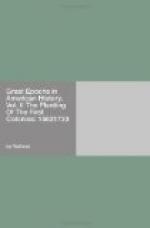[1] From Doyle’s “English
Colonies in America.” By permission of
the publishers, Henry Holt
& Co.
[2] Coligny’s first
attempt was made in 1555, when two shiploads of
Huguenot immigrants (290 persons),
under Villegagnon, were sent to
Brazil. This settlement
was soon destroyed by the Portuguese.
Menendez’s expedition of 1565 followed the earlier Spanish expeditions by Ponce de Leon, Narvaez and De Soto. It sailed from Cadiz and comprized eleven ships. Twenty-three other vessels followed, the entire company numbering 2,646 persons. The aim of Menendez was to begin a permanent settlement in Florida. On arrival he found a colony of French Huguenots already in possession, having been there three years. A conflict was inevitable, and one which forms a most melancholy chapter in the early history of American colonization. Menendez hanged Huguenots, “not as Frenchmen, but as heretics,” while Gourgues hanged Spaniards “not as Spaniards, but as traitors, robbers and murderers.” After the conflicts closed the Spaniards maintained themselves in St. Augustine until 1586, when St. Augustine was completely destroyed by Sir Francis Drake. Two years later the Armada of Spain was overthrown in the English Channel, largely as the work of Drake.
[3] In the valley of the St. Lawrence as described in Volume I.
[4] St. Quentin is a town
in northeastern France, near which on
August 10, 1557, the army
of Philip II, Spain, won a great victory
over the combined armies of
France and England.
II
Mendoza’s account of the massacre[1]
We saw two islands, called the Bahama Islands. The shoals which lie between them are so extensive that the billows are felt far out at sea. The general gave orders to take soundings. The ship purchased at Porto Rico got aground that day in two and a half fathoms of water. At first we feared she might stay there; but she soon got off and came to us. Our galley, one of the best chips afloat, found herself all day in the same position, when suddenly her keel struck three times violently against the bottom. The sailors gave themselves up for lost, and the water commenced to pour into her hold. But, as we had a mission to fulfil for Jesus Christ and His blessed mother, two heavy waves, which struck her abaft, set her afloat again, and soon after we found her in deep water, and at midnight we entered the Bahama Channel.
On Saturday, the 25th, the captain-general (Menendez) came to visit our vessel and get the ordnance for disembarkment at Florida. This ordnance consisted of two rampart pieces, of two sorts of culverins, of very small caliber, powder and balls; and he also took two soldiers to take care of the pieces. Having armed his vessel, he stopt and made us an address, in which he instructed us what we had to do on arrival




